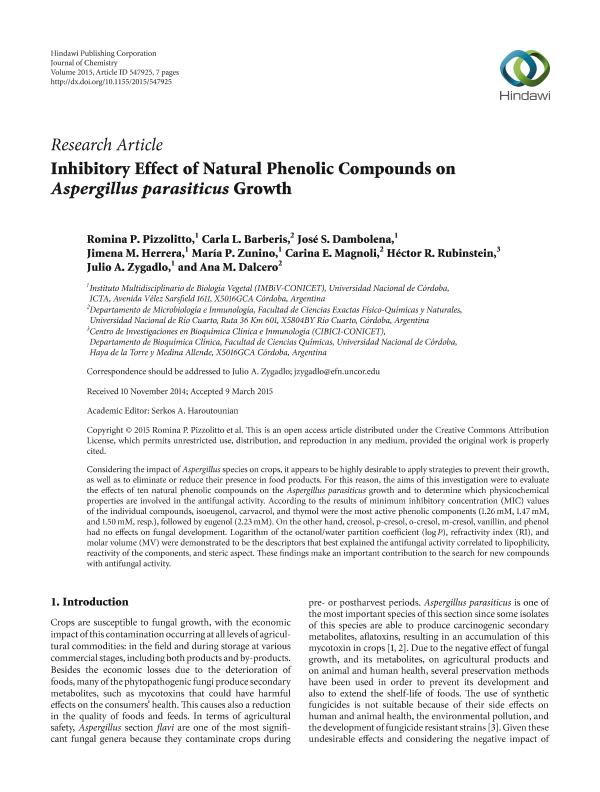Artículo
Inhibitory Effect of Natural Phenolic Compounds on Aspergillus parasiticus Growth
Pizzolitto, Romina Paola ; Barberis, Carla Lorena
; Barberis, Carla Lorena ; Dambolena, Jose Sebastian
; Dambolena, Jose Sebastian ; Herrera, Jimena María
; Herrera, Jimena María ; Zunino, María Paula
; Zunino, María Paula ; Magnoli, Carina Elizabeth
; Magnoli, Carina Elizabeth ; Rubinstein, Héctor R.; Zygadlo, Julio Alberto
; Rubinstein, Héctor R.; Zygadlo, Julio Alberto ; Dalcero, Ana Maria
; Dalcero, Ana Maria
 ; Barberis, Carla Lorena
; Barberis, Carla Lorena ; Dambolena, Jose Sebastian
; Dambolena, Jose Sebastian ; Herrera, Jimena María
; Herrera, Jimena María ; Zunino, María Paula
; Zunino, María Paula ; Magnoli, Carina Elizabeth
; Magnoli, Carina Elizabeth ; Rubinstein, Héctor R.; Zygadlo, Julio Alberto
; Rubinstein, Héctor R.; Zygadlo, Julio Alberto ; Dalcero, Ana Maria
; Dalcero, Ana Maria
Fecha de publicación:
03/2015
Editorial:
Hindawi Publishing Corporation
Revista:
E-journal Of Chemistry
ISSN:
0973-4945
e-ISSN:
2090-9810
Idioma:
Inglés
Tipo de recurso:
Artículo publicado
Clasificación temática:
Resumen
Considering the impact of Aspergillus species on crops, it appears to be highly desirable to apply strategies to prevent their growth, as well as to eliminate or reduce their presence in food products. For this reason, the aims of this investigation were to evaluate the effects of ten natural phenolic compounds on the Aspergillus parasiticus growth and to determine which physicochemical properties are involved in the antifungal activity. According to the results of minimum inhibitory concentration (MIC) values of the individual compounds, isoeugenol, carvacrol, and thymol were the most active phenolic components (1.26 mM, 1.47 mM,and 1.50 mM, resp.), followed by eugenol (2.23 mM). On the other hand, creosol, p-cresol, o-cresol, m-cresol, vanillin, and phenol had no effects on fungal development. Logarithm of the octanol/water partition coefficient (log P), refractivity index (RI), and molar volume (MV) were demonstrated to be the descriptors that best explained the antifungal activity correlated to lipophilicity, reactivity of the components, and steric aspect. These findings make an important contribution to the search for new compounds with antifungal activity
Archivos asociados
Licencia
Identificadores
Colecciones
Articulos(IMBIV)
Articulos de INST.MULTIDISCIPL.DE BIOLOGIA VEGETAL (P)
Articulos de INST.MULTIDISCIPL.DE BIOLOGIA VEGETAL (P)
Citación
Pizzolitto, Romina Paola; Barberis, Carla Lorena; Dambolena, Jose Sebastian; Herrera, Jimena María; Zunino, María Paula; et al.; Inhibitory Effect of Natural Phenolic Compounds on Aspergillus parasiticus Growth; Hindawi Publishing Corporation; E-journal Of Chemistry; 2015; 3-2015; 7-14
Compartir
Altmétricas



